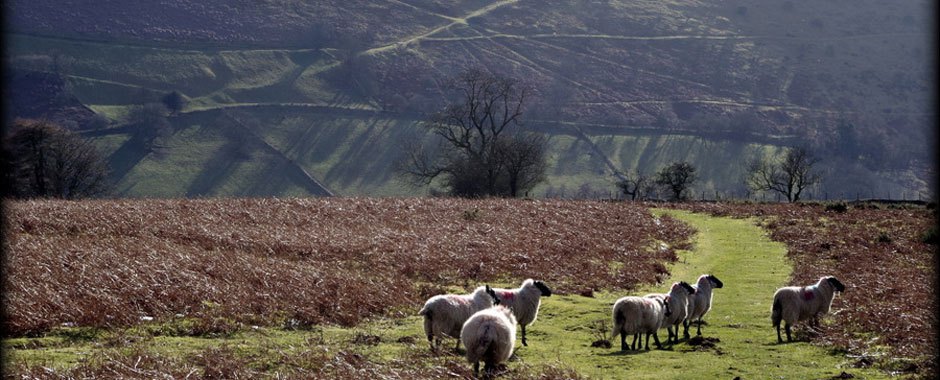Livestock keeping is seen by some as a scourge on ‘natural’ landscapes, creating devastation through grazing and browsing. Reversion to some form of idealised ‘wilderness’ is seen as the solution, with value created through improved aesthetics, tourism and enhanced ecosystem services.This has been a focus by the ‘re-wilding’ debate.
This takes on many forms, but one of its most articulate and vocal advocates is George Monbiot, a British journalist based in Wales. He really hates sheep and the way sheep farming is, in his view, destroying the hills and mountains. Instead he argues that letting such ecosystems revert to ‘natural’ vegetation, with the reintroduction of ‘native’ species would enhance the landscape enormously, providing alternative sources of employment and use. He saves some of his ire also for grouse shooting, particularly in British national parks, where burning to keep the grouse habitat is seen as anathema to his vision of an appropriate upland landscape, and benefits only an elite minority.
This debate is not exclusive to the upland areas of Britain, but is extended across Europe, where the reintroduction and then spread of large predators, such as bears and wolves, has caused much controversy. This is seen to be threatening traditional pastoral systems, already under extreme pressure through rural depopulation, and declining economies. Without sufficient herding labour flocks can be attacked, and animals decimated, wiping out livelihoods at a stroke.
While some tourists in the mountains may be thrilled by the sight of a wolf or a bear, many see them as introduced pests. Furthermore, not everyone is convinced that, by removing grazers and browsers, the new woodland scrub that emerges is the most aesthetic. In time larger stand forests may take over, but with these the open vistas and what many see as classic mountain landscapes disappear. I live on the edge of a populated national park on the South Downs of England, and the local council has its own flock of sheep to manage its own land. Many nature trusts around the country do too. Chalk down land is a classic constructed landscape, created over hundreds of years by human activity. It is not necessarily ‘degraded’ because it’s not ‘wild’, but for many, it is what is valued – and sheep are integral.
Of course this is not a debate about science. It’s about politics and who controls nature. Wilderness as an idea emerged in the national parks movement in the US. Yellowstone was the first and archetypical example. This idea extended through colonialism across Africa, for example, as national parks were established and people excluded. Some such wild areas were kept for hunting, and the exclusive use of a privileged white settler class who came to Africa for macho exploits and trophies. The expansion of national parks accelerated from the 1960s as the conservation movement gained support, and today continues, with private parks and conservancies carved out as playgrounds for a global elite.
Such wild spaces are always managed. Fences are put up, certain species introduced, burning and vegetation management regimes are elaborated. Conservation science is all about this, managing for different ends: biodiversity, aesthetics, economic value and so on. It’s all about choices; ‘naturalness’ doesn’t come into it. Monbiot’s choice is one, the poor sheep farmers who live nearby him is another.
And it’s not just about biodiversity science, ecosystem economics or human aesthetics; it’s also about class, control and sometimes race. Those who created hunting blocks in Africa, excluding local people and their livestock, were an elite, white settler class; those who support grouse hunting on the moors of Scotland come from similarly privileged backgrounds. A middle-class, urban aesthetic that doesn’t see livestock production as an essential part of lived-in landscapes is another increasingly common narrative, seen for example in the US as visions of the ‘the environment’ spread from the coast to the mid-west rangeland areas. It’s often justified in ecological terms, with fears of degradation and biodiversity loss emphasised, and so making the case for expanding national parks or manufacturing wilderness in formerly livestock producing areas. Of course degradation can result from livestock production, and species composition can change too. But negative changes can result from ‘wild’ systems also; just look at the devastation caused by elephants in some protected areas of Botswana and Zimbabwe.
This is not the point: it’s a question of what landscapes people want, and who benefits from these. Where are the voices of livestock keepers in all these debates? Whether it’s the sheep farmers of Wales or the pastoralists of East Africa, they are often not given a voice. The political choices about landscape – and so livelihoods and economic – change must involve everyone, and particularly those often poor and marginalised people who have lived in these areas for millennia.
This blog post was originally published on the PASTRES website.
